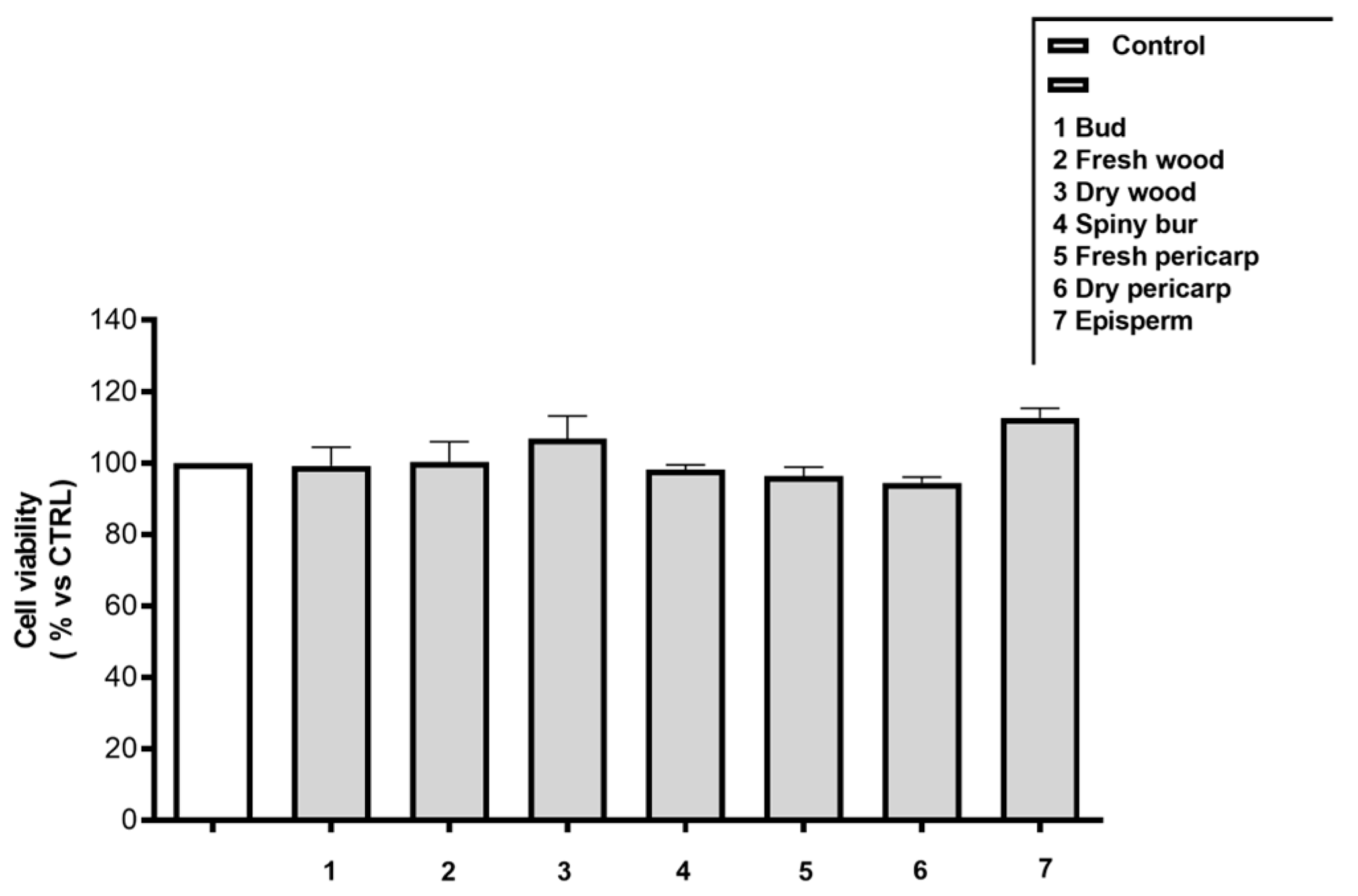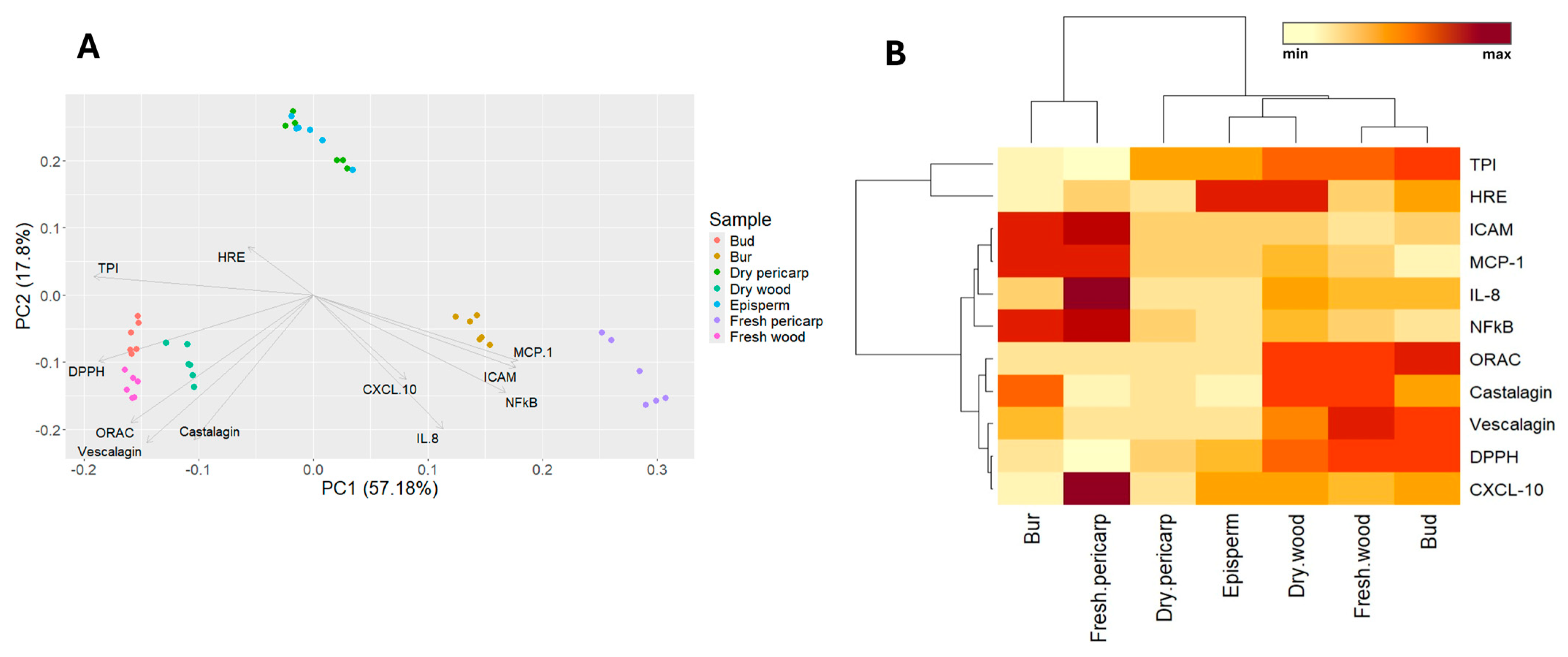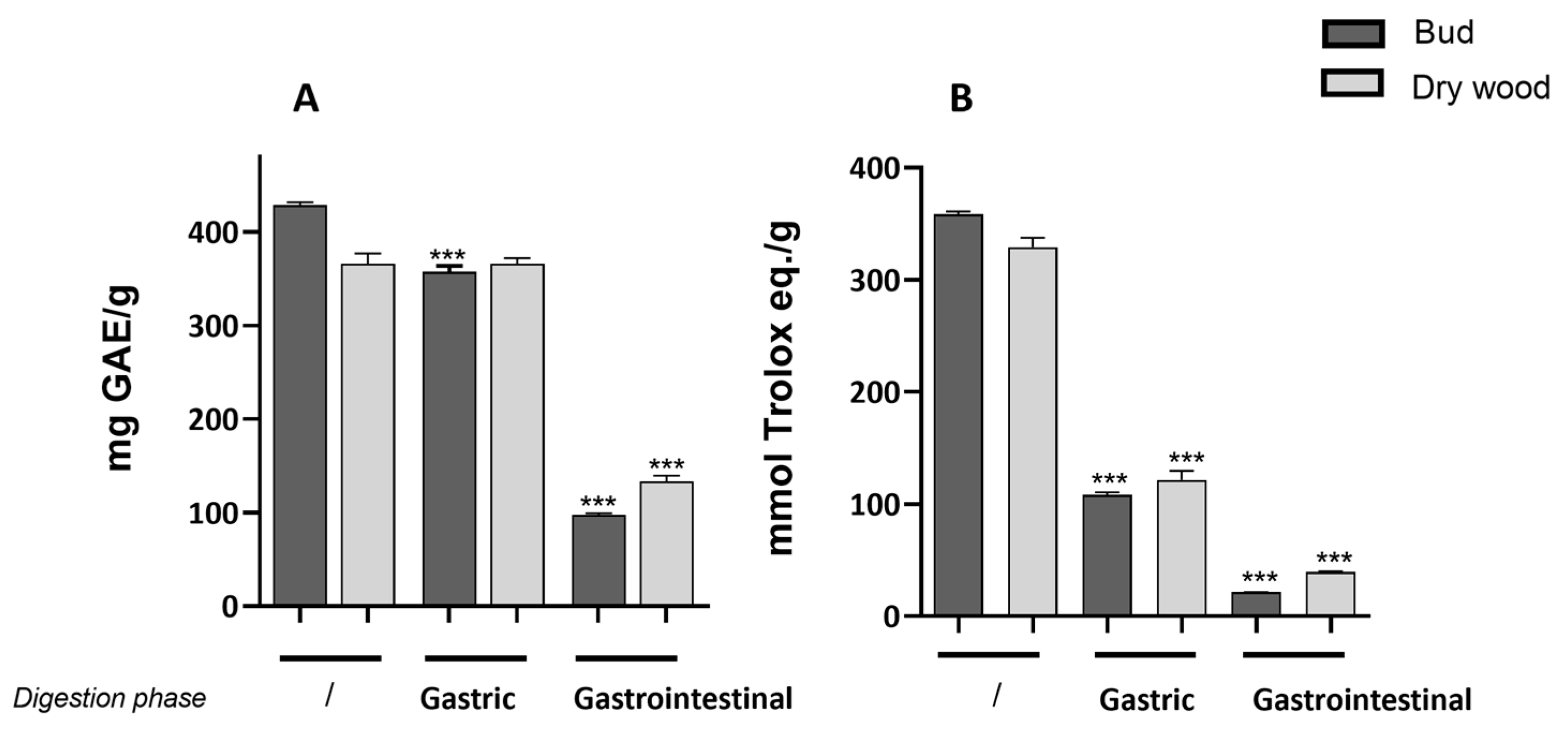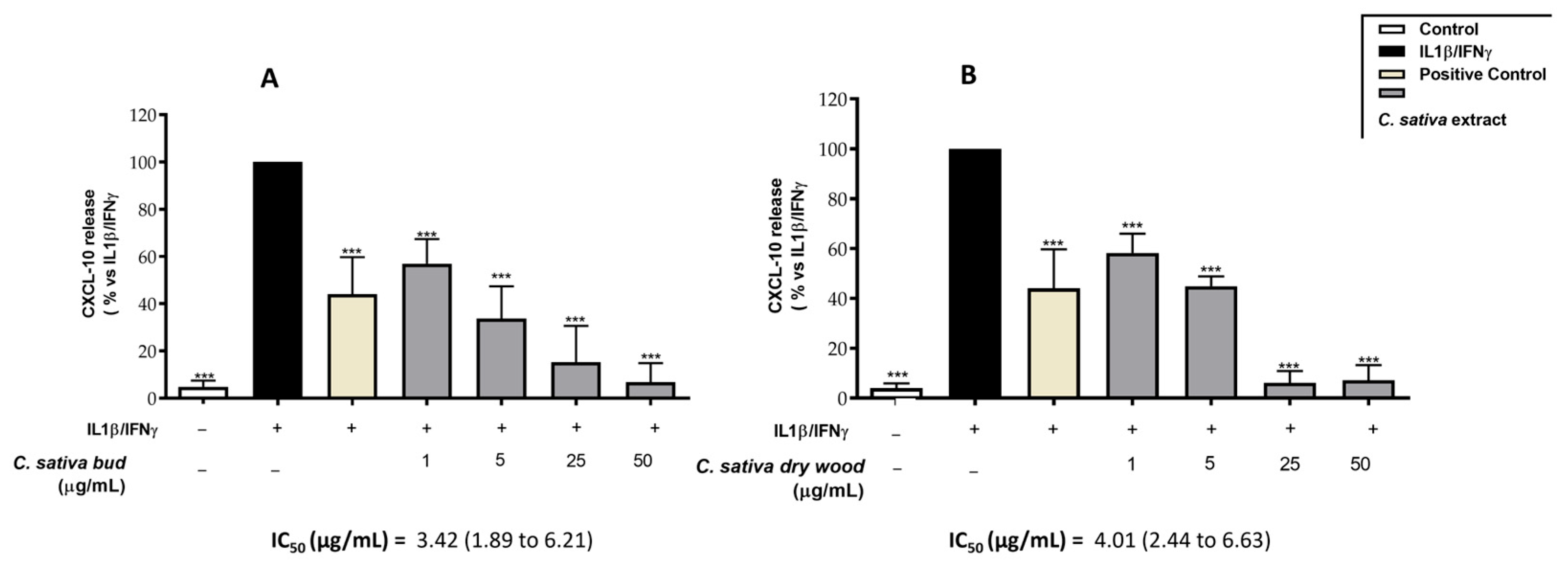Castanea sativa Mill. By-Products: Investigation of Potential Anti-Inflammatory Effects in Human Intestinal Epithelial Cells
Abstract
1. Introduction
2. Results and Discussion
2.1. Chemical Characterization and Scavenging Capacity
2.2. Anti-Inflammatory Properties
2.3. Identification of Promising Chestnut By-Products as Anti-Inflammatory Agents in the Gut
2.4. Stability of Promising Chestnut By-Products
3. Materials and Methods
3.1. Materials
3.2. Sample Harvesting and Extraction
3.3. Extract Characterization
3.3.1. Total Polyphenol Index (TPI)
3.3.2. Quantification of Ellagitannins
3.3.3. Polyphenolic Fingerprint
3.4. In Vitro Evaluation of the Anti-Inflammatory Activity
3.4.1. Cell Culture and Treatment
3.4.2. Cell Viability
3.4.3. Measurement of Inflammatory Markers
3.4.4. Measurement of the NF-κB-Driven Transcription
3.4.5. Measurement of the HRE-Driven Transcription
3.4.6. Gastrointestinal Digestion
3.5. Scavenging Capacity
3.5.1. ORAC Test
3.5.2. DPPH Test
3.6. Statistical Analysis
4. Conclusions
Author Contributions
Funding
Institutional Review Board Statement
Informed Consent Statement
Data Availability Statement
Conflicts of Interest
Appendix A


References
- Food and Agriculture Organization of the United Nations. 2021. Available online: http://www.fao.org/home/en/ (accessed on 4 November 2021).
- De Vasconcelos, M.C.; Bennett, R.N.; Rosa, E.A.; Ferreira-Cardoso, J.V. Composition of European chestnut (Castanea sativa Mill.) and association with health effects: Fresh and processed products. J. Sci. Food Agric. 2010, 90, 1578–1589. [Google Scholar] [CrossRef] [PubMed]
- Braga, N.; Rodrigues, F.; Oliveira, M.B. Castanea sativa by-products: A review on added value and sustainable application. Nat. Prod. Res. 2015, 29, 1–18. [Google Scholar] [CrossRef]
- Pinto, D.; Rodrigues, F.; Braga, N.; Santos, J.; Pimentel, F.B.; Palmeira-de-Oliveira, A.; Oliveira, M.B. The Castanea sativa bur as a new potential ingredient for nutraceutical and cosmetic outcomes: Preliminary studies. Food Funct. 2017, 8, 201–208. [Google Scholar] [CrossRef] [PubMed]
- Fernández-Agulló, A.; Freire, M.S.; Antorrena, G.; Pereira, J.A.; González-Alvarez, J. Effect of the Extraction Technique and Operational Conditions on the Recovery of Bioactive Compounds from Chestnut Bur and Shell. Sep. Sci. Technol. 2014, 49, 267–277. [Google Scholar] [CrossRef]
- Vázquez, G.; González-Alvarez, J.; Freire, M.S.; Fernández-Agulló, A.; Santos, J.; Antorrena, G. Chestnut Burs as a Source of Natural Antioxidants. Chem. Eng. Trans. 2009, 17, 855–860. [Google Scholar] [CrossRef]
- Esposito, T.; Celano, R.; Pane, C.; Piccinelli, A.L.; Sansone, F.; Picerno, P.; Zaccardelli, M.; Aquino, R.P.; Mencherini, T. Chestnut (Castanea sativa Miller.) Burs Extracts and Functional Compounds: UHPLC-UV-HRMS Profiling, Antioxidant Activity, and Inhibitory Effects on Phytopathogenic Fungi. Molecules 2019, 24, 302. [Google Scholar] [CrossRef]
- Chiocchio, I.; Prata, C.; Mandrone, M.; Ricciardiello, F.; Marrazzo, P.; Tomasi, P.; Angeloni, C.; Fiorentini, D.; Malaguti, M.; Poli, F.; et al. Leaves and Spiny Burs of Castanea sativa from an Experimental Chestnut Grove: Metabolomic Analysis and Anti-Neuroinflammatory Activity. Metabolites 2020, 10, 408. [Google Scholar] [CrossRef]
- Marrazzo, P.; Mandrone, M.; Chiocchio, I.; Zambonin, L.; Barbalace, M.C.; Zalambani, C.; Angeloni, C.; Malaguti, M.; Prata, C.; Poli, F.; et al. By-Product Extracts from Castanea sativa Counteract Hallmarks of Neuroinflammation in a Microglial Model. Antioxidants 2023, 12, 808. [Google Scholar] [CrossRef]
- Cerulli, A.; Napolitano, A.; Hosek, J.; Masullo, M.; Pizza, C.; Piacente, S. Antioxidant and In Vitro Preliminary Anti-Inflammatory Activity of Castanea sativa (Italian Cultivar “Marrone di Roccadaspide” PGI) Burs, Leaves, and Chestnuts Extracts and Their Metabolite Profiles by LC-ESI/LTQOrbitrap/MS/MS. Antioxidants 2021, 10, 278. [Google Scholar] [CrossRef]
- Piazza, S.; Martinelli, G.; Fumagalli, M.; Pozzoli, C.; Maranta, N.; Giavarini, F.; Colombo, L.; Nicotra, G.; Vicentini, S.F.; Genova, F.; et al. Ellagitannins from Castanea sativa Mill. Leaf Extracts Impair H. pylori Viability and Infection-Induced Inflammation in Human Gastric Epithelial Cells. Nutrients 2023, 15, 1504. [Google Scholar] [CrossRef]
- Sangiovanni, E.; Piazza, S.; Vrhovsek, U.; Fumagalli, M.; Khalilpour, S.; Masuero, D.; Di Lorenzo, C.; Colombo, L.; Mattivi, F.; De Fabiani, E.; et al. A bio-guided approach for the development of a chestnut-based proanthocyanidin-enriched nutraceutical with potential anti-gastritis properties. Pharmacol. Res. 2018, 134, 145–155. [Google Scholar] [CrossRef]
- Martin, D.A.; Bolling, B.W. A review of the efficacy of dietary polyphenols in experimental models of inflammatory bowel diseases. Food Funct. 2015, 6, 1773–1786. [Google Scholar] [CrossRef]
- González-Quilen, C.; Rodríguez-Gallego, E.; Beltrán-Debón, R.; Pinent, M.; Ardévol, A.; Blay, M.T.; Terra, X. Health-Promoting Properties of Proanthocyanidins for Intestinal Dysfunction. Nutrients 2020, 12, 130. [Google Scholar] [CrossRef] [PubMed]
- Piazza, S.; Fumagalli, M.; Martinelli, G.; Pozzoli, C.; Maranta, N.; Angarano, M.; Sangiovanni, E.; Dell’Agli, M. Hydrolyzable Tannins in the Management of Th1, Th2 and Th17 Inflammatory-Related Diseases. Molecules 2022, 27, 7593. [Google Scholar] [CrossRef] [PubMed]
- Chen, H.; Li, Y.; Wang, J.R.; Zheng, T.T.; Wu, C.Y.; Cui, M.Y.; Feng, Y.F.; Ye, H.Y.; Dong, Z.Q.; Dang, Y.J. Polyphenols Attenuate DSS-induced Ulcerative Colitis in Mice via Antioxidation, Anti-inflammation and Microbiota Regulation. Int. J. Mol. Sci. 2023, 24, 10828. [Google Scholar] [CrossRef]
- Hossen, I.; Hua, W.; Ting, L.; Mehmood, A.; Jingyi, S.; Duoxia, X.; Yanping, C.; Hongqing, W.; Zhipeng, G.; Kaiqi, Z.; et al. Phytochemicals and inflammatory bowel disease: A review. Crit. Rev. Food Sci. 2020, 60, 1321–1345. [Google Scholar] [CrossRef]
- Laurindo, L.F.; dos Santos, A.R.D.; de Carvalho, A.C.A.; Bechara, M.D.; Guiguer, E.L.; Goulart, R.D.; Sinatora, R.V.; Araujo, A.C.; Barbalho, S.M. Phytochemicals and Regulation of NF-kB in Inflammatory Bowel Diseases: An Overview of In Vitro and In Vivo Effects. Metabolites 2023, 13, 96. [Google Scholar] [CrossRef]
- Bourgonje, A.R.; Kloska, D.; Grochot-Przeczek, A.; Feelisch, M.; Cuadrado, A.; van Goor, H. Personalized redox medicine in inflammatory bowel diseases: An emerging role for HIF-1α and NRF2 as therapeutic targets. Redox Biol. 2023, 60, 102603. [Google Scholar] [CrossRef]
- Kerber, E.L.; Padberg, C.; Koll, N.; Schuetzhold, V.; Fandrey, J.; Winning, S. The Importance of Hypoxia-Inducible Factors (HIF-1 and HIF-2) for the Pathophysiology of Inflammatory Bowel Disease. Int. J. Mol. Sci. 2020, 21, 8551. [Google Scholar] [CrossRef]
- Gupta, R.; Chaudhary, A.R.; Shah, B.N.; Jadhav, A.V.; Zambad, S.P.; Gupta, R.C.; Deshpande, S.; Chauthaiwale, V.; Dutt, C. Therapeutic treatment with a novel hypoxia-inducible factor hydroxylase inhibitor (TRC160334) ameliorates murine colitis. Clin. Exp. Gastroenterol. 2014, 7, 13–23. [Google Scholar] [CrossRef][Green Version]
- Triantafyllou, A.; Mylonis, L.; Simos, G.; Bonanou, S.; Tsakalof, A. Flavonoids induce HIF-1α but impair its nuclear accumulation and activity. Free. Radic. Biol. Med. 2008, 44, 657–670. [Google Scholar] [CrossRef]
- Vella, F.M.; De Masi, L.; Calandrelli, R.; Morana, A.; Laratta, B. Valorization of the agro-forestry wastes from Italian chestnut cultivars for the recovery of bioactive compounds. Eur. Food Res. Technol. 2019, 245, 2679–2686. [Google Scholar] [CrossRef]
- Yang, F.; Wei, D.; Li, J.; Xie, C.Y. Chestnut shell represents a rich source of polyphenols: Preparation methods, antioxidant activity and composition analysis of extractable and non-extractable polyphenols. Eur. Food Res. Technol. 2023, 249, 1273–1285. [Google Scholar] [CrossRef]
- Pinto, D.; Vieira, E.F.; Peixoto, A.F.; Freire, C.; Freitas, V.; Costa, P.; Delerue-Matos, C.; Rodrigues, F. Optimizing the extraction of phenolic antioxidants from chestnut shells by subcritical water extraction using response surface methodology. Food Chem. 2021, 334, 127521. [Google Scholar] [CrossRef] [PubMed]
- Comandini, P.; Lerma-García, M.J.; Simó-Alfonso, E.F.; Toschi, T.G. Tannin analysis of chestnut bark samples (Castanea sativa Mill.) by HPLC-DAD–MS. Food Chem. 2014, 157, 290–295. [Google Scholar] [CrossRef]
- Pinto, D.; Ferreira, A.S.; Lozano-Castellón, J.; Laveriano-Santos, E.P.; Lamuela-Raventós, R.M.; Vallverdú-Queralt, A.; Delerue-Matos, C.; Rodrigues, F. Exploring the Impact of In Vitro Gastrointestinal Digestion in the Bioaccessibility of Phenolic-Rich Chestnut Shells: A Preliminary Study. Separations 2023, 10, 471. [Google Scholar] [CrossRef]
- Cerulli, A.; Napolitano, A.; Masullo, M.; Hosek, J.; Pizza, C.; Piacente, S. Chestnut shells (Italian cultivar “Marrone di Roccadaspide” PGI): Antioxidant activity and chemical investigation with in depth LC-HRMS/MSn rationalization of tannins. Food Res. Int. 2020, 129, 108787. [Google Scholar] [CrossRef] [PubMed]
- Abd El-Hack, M.E.; de Oliveira, M.C.; Attia, Y.A.; Kamal, M.; Almohmadi, N.H.; Youssef, I.M.; Khalifa, N.E.; Moustafa, M.; Al-Shehri, M.; Taha, A.E. The efficacy of polyphenols as an antioxidant agent: An updated review. Int. J. Biol. Macromol. 2023, 250, 126525. [Google Scholar] [CrossRef]
- Santos, S.C.; Fortes, G.A.C.; Camargo, L.T.F.M.; Camargo, A.J.; Ferri, P.H. Antioxidant effects of polyphenolic compounds and structure-activity relationship predicted by multivariate regression tree. LWT-Food Sci. Technol. 2021, 137, 110366. [Google Scholar] [CrossRef]
- Silva, V.; Falco, V.; Dias, M.I.; Barros, L.; Silva, A.; Capita, R.; Alonso-Calleja, C.; Amaral, J.S.; Igrejas, G.; Ferreira, I.C.F.R.; et al. Evaluation of the Phenolic Profile of Castanea sativa Mill. By-Products and Their Antioxidant and Antimicrobial Activity against Multiresistant Bacteria. Antioxidants 2020, 9, 87. [Google Scholar] [CrossRef] [PubMed]
- Rodrigues, D.B.; Verissimo, L.; Finimundy, T.; Rodrigues, J.; Oliveira, I.; Gonçalves, J.; Fernandes, I.P.; Barros, L.; Heleno, S.A.; Calhelha, R.C. Chemical and Bioactive Screening of Green Polyphenol-Rich Extracts from Chestnut By-Products: An Approach to Guide the Sustainable Production of High-Added Value Ingredients. Foods 2023, 12, 2596. [Google Scholar] [CrossRef]
- Sanz, M.; Cadahia, E.; Esteruelas, E.; Munoz, A.M.; Fernandez de Simon, B.; Hernandez, T.; Estrella, I. Phenolic compounds in chestnut (Castanea sativa Mill.) heartwood. Effect of toasting at cooperage. J. Agric. Food Chem. 2010, 58, 9631–9640. [Google Scholar] [CrossRef]
- Van De Walle, J.; Hendrickx, A.; Romier, B.; Larondelle, Y.; Schneider, Y.J. Inflammatory parameters in Caco-2 cells: Effect of stimuli nature, concentration, combination and cell differentiation. Toxicol. Vitr. 2010, 24, 1441–1449. [Google Scholar] [CrossRef]
- Romier-Crouzet, B.; Van De Walle, J.; During, A.; Joly, A.; Rousseau, C.; Henry, O.; Larondelle, Y.; Schneider, Y.J. Inhibition of inflammatory mediators by polyphenolic plant extracts in human intestinal Caco-2 cells. Food Chem. Toxicol. 2009, 47, 1221–1230. [Google Scholar] [CrossRef]
- Piazza, S.; Bani, C.; Colombo, F.; Mercogliano, F.; Pozzoli, C.; Martinelli, G.; Petroni, K.; Pilu, S.R.; Sonzogni, E.; Fumagalli, M.; et al. Pigmented corn as a gluten-free source of polyphenols with anti-inflammatory and antioxidant properties in CaCo-2 cells. Food Res. Int. 2024, 191, 114640. [Google Scholar] [CrossRef] [PubMed]
- Uguccioni, M.; Gionchetti, P.; Robbiani, D.F.; Rizzello, F.; Peruzzo, S.; Campieri, M.; Baggiolini, M. Increased expression of IP-10, IL-8, MCP-1, and MCP-3 in ulcerative colitis. Am. J. Pathol. 1999, 155, 331–336. [Google Scholar] [CrossRef] [PubMed]
- Schottelius, A.J.G.; Baldwin, A.S. A role for transcription factor NF-κB in intestinal inflammation. Int. J. Colorectal Dis. 1999, 14, 18–28. [Google Scholar] [CrossRef] [PubMed]
- Singhal, R.; Shah, Y.M. Oxygen battle in the gut: Hypoxia and hypoxia-inducible factors in metabolic and inflammatory responses in the intestine. J. Biol. Chem. 2020, 295, 10493–10505. [Google Scholar] [CrossRef] [PubMed]
- Repetto, G.; del Peso, A.; Zurita, J.L. Neutral red uptake assay for the estimation of cell viability/cytotoxicity. Nat. Protoc. 2008, 3, 1125–1131. [Google Scholar] [CrossRef]
- Hoensch, H.P.; Weigmann, B. Regulation of the intestinal immune system by flavonoids and its utility in chronic inflammatory bowel disease. World J. Gastroenterol. 2018, 24, 877–881. [Google Scholar] [CrossRef]
- Sangiovanni, E.; Di Lorenzo, C.; Colombo, E.; Colombo, F.; Fumagalli, M.; Frigerio, G.; Restani, P.; Dell’Agli, M. The effect of in vitro gastrointestinal digestion on the anti-inflammatory activity of Vitis vinifera L. leaves. Food Funct. 2015, 6, 2453–2463. [Google Scholar] [CrossRef] [PubMed]
- Fracassetti, D.; Costa, C.; Moulay, L.; Tomás-Barberán, F.A. Ellagic acid derivatives, ellagitannins, proanthocyanidins and other phenolics, vitamin C and antioxidant capacity of two powder products from camu-camu fruit. Food Chem. 2013, 139, 578–588. [Google Scholar] [CrossRef] [PubMed]





| TPI 1 | ORAC Assay | DPPH Assay | Vescalagin | Castalagin | |
|---|---|---|---|---|---|
| (mg GAE 2/g ± SEM 3) | (mmol Trolox Equivalent/g ± SEM) | (mmol Trolox Equivalent/g ± SEM) | (µg/g ± SEM) | (µg/g ± SEM) | |
| Bud | 428.4 ± 3.3 a | 51 ± 1.8 c | 7.2 ± 0 f | 19.2 ± 0.1 b | 20.5 ± 0.0 d |
| Fresh wood | 391.2 ± 1.3 b | 46 ± 1.7 b | 7.3 ± 0.1 f | 21.4 ± 0.2 a | 41.3 ± 0.2 a |
| Dry wood | 365.6 ± 11.4 c | 47 ± 1.0 b | 6.6 ± 0.2 e | 12.7 ± 0.0 c | 39.4 ± 0.1 b |
| Dry pericarp | 287.2 ± 8.4 e | 17.8 ± 0.0 a | 2.77 ± 0.07 c | 0.4 ± 0.0 e | 6.9 ± 0.1 e |
| Fresh pericarp | 54.9 ± 7.3 g | 16.4 ± 10.1 a | 0.17 ± 0.03 a | 0.29 ± 0.0 e | 2.11 ± 0.0 g |
| Episperm | 314.3 ± 12.1 d | 17.3 ± 0.1 a | 3.11 ± 0.14 d | 0.34 ± 0.0 e | 3.55 ± 0.0 f |
| Spiny bur | 117.5 ± 7.0 f | 17.1 ± 0.1 a | 1.39 ± 0.14 b | 7.4 ± 0.7 d | 32.4 ± 0.5 c |
| N | RT | (M-H) | Product Ion (m/z) | Putative Identified Molecule | B | SB | W | P | E |
|---|---|---|---|---|---|---|---|---|---|
| 1 | 3.18 | 191 | 129, 146, 159 173 | quinic acid | x | x | |||
| 2 | 5.31 | 337 | 293 | hexahydroxydiphenic acid | x | x | |||
| 3 | 5.49 | 609 | 305, 423, 441, 483, 591 | condensed tannin GC-GC-B type | x | ||||
| 4 | 5.60 | 933 | 411, 631, 915 | castalagin/vescalagin | x | ||||
| 5 | 5.99 | 317 | 136, 155 | phenol glucoside (crenatin) | x | ||||
| 6 | 5.63 | 609 | 305, 423, 441, 483, 591 | condensed tannin GC-GC-B type | x | ||||
| 7 | 6.12 | 933 | 658, 897, 899 | castalagin/vescalagin | x | x | x | ||
| 8 | 6.13 | 935 | 481, 782, 863, 915, 916, 917 | stachyurin | x | ||||
| 9 | 6.63 | 613 | 299, 300, 493, 494 | castacrenin B | x | ||||
| 10 | 6.95 | 483 | 169, 211, 241. 270, 312, 331, 415, 465 | digalloyl glucose isomer | x | ||||
| 11 | 6.98 | 933 | 348, 451, 631 | castalagin, vescalagin | x | ||||
| 12 | 7.18 | 289 | 179, 205, 245 | catechin | x | ||||
| 13 | 7.22 | 635 | 313, 465, 483, 603, 604 | trigalloyl glucose isomer | x | ||||
| 14 | 7.23 | 637 | 305, 467, 469, 593 | chesnatin | x | ||||
| 15 | 7.83 | 937 | 467, 469, 637 | chestanin | x | ||||
| 16 | 7.96 | 469 | 168, 425 | cretanin | x | ||||
| 17 | 8.34 | 621 | 313, 317, 451, 469, 577 | galloyl cretanin | x | ||||
| 18 | 9.13 | 433 | 300, 301, 302, 369 | ellagic acid pentoside | x | x | x | ||
| 19 | 9.61 | 301 | 184, 201, 228, 257, 283 | ellagic acid | x | ||||
| 20 | 9.67 | 447 | 315, 316 | astragalin | x | ||||
| 21 | 9.81 | 343 | 297, 312, 328, 329 | trimethylellagic acid | x | ||||
| 22 | 9.85 | 461 | 315, 328, 446 | dimethylellagic acid pentoside | x | ||||
| 23 | 10.82 | 329 | 314 | dimethylellagic acid | x | x | |||
| 24 | 11.53 | 343 | 298, 313, 328, 329 | trimethylellagic acid | x | x | |||
| 25 | 15.18 | 461 | 222, 445, 446 | dimethylellagic acid pentoside | x |
| CXCL-10 | IL-8 | MCP-1 | NF-κB | |||||
|---|---|---|---|---|---|---|---|---|
| IC50 (μg/mL) | CI (95%) | IC50 (μg/mL) | CI (95%) | IC50 (μg/mL) | CI (95%) | IC50 (μg/mL) | CI (95%) | |
| Bud | 2.13 | 1.68–2.70 | 10.10 | 7.26–14.05 | 8.01 | 5.55–11.55 | 14.65 | 13.71–15.67 |
| Bur | 4.50 | 3.58–5.66 | 3.67 | 2.68–5.01 | 25.37 | 18.17–35.43 | n.d. | |
| Fresh Wood | 1.43 | 0.99–2.06 | 7.58 | 5.12–11.21 | 13.08 | 8.63–19.82 | 17.49 | 12.36–24.74 |
| Dry Wood | 1.28 | 0.78–2.09 | 21.26 | 14.65–30.86 | 23.81 | 18.08–31.35 | 31.96 | 27.93–36.58 |
| Fresh Pericarp | 7.34 | 6.03–8.94 | n.d. | n.d. | n.d. | |||
| Dry Pericarp | 1.82 | 1.14–2.91 | 8.01 | 6.69–9.59 | 3.15 | 2.07–4.77 | 2.36 | 1.12–5.02 |
| Episperm | 1.64 | 0.95–2.82 | 3.91 | 2.83–6.42 | 6.42 | 4.50–9.15 | 2.27 | 1.65–3.10 |
| Before Digestion | After Digestion | |||
|---|---|---|---|---|
| CXCL-10 | IC50 (μg/mL) | CI (95%) | IC50 (μg/mL) | CI (95%) |
| Bud | 2.13 | 1.68–2.70 | 3.42 | 1.89–6.21 |
| Dry Wood | 1.28 | 0.78–2.09 | 4.01 | 2.44–6.63 |
Disclaimer/Publisher’s Note: The statements, opinions and data contained in all publications are solely those of the individual author(s) and contributor(s) and not of MDPI and/or the editor(s). MDPI and/or the editor(s) disclaim responsibility for any injury to people or property resulting from any ideas, methods, instructions or products referred to in the content. |
© 2024 by the authors. Licensee MDPI, Basel, Switzerland. This article is an open access article distributed under the terms and conditions of the Creative Commons Attribution (CC BY) license (https://creativecommons.org/licenses/by/4.0/).
Share and Cite
Pozzoli, C.; Martinelli, G.; Fumagalli, M.; Di Lorenzo, C.; Maranta, N.; Colombo, L.; Piazza, S.; Dell’Agli, M.; Sangiovanni, E. Castanea sativa Mill. By-Products: Investigation of Potential Anti-Inflammatory Effects in Human Intestinal Epithelial Cells. Molecules 2024, 29, 3951. https://doi.org/10.3390/molecules29163951
Pozzoli C, Martinelli G, Fumagalli M, Di Lorenzo C, Maranta N, Colombo L, Piazza S, Dell’Agli M, Sangiovanni E. Castanea sativa Mill. By-Products: Investigation of Potential Anti-Inflammatory Effects in Human Intestinal Epithelial Cells. Molecules. 2024; 29(16):3951. https://doi.org/10.3390/molecules29163951
Chicago/Turabian StylePozzoli, Carola, Giulia Martinelli, Marco Fumagalli, Chiara Di Lorenzo, Nicole Maranta, Luca Colombo, Stefano Piazza, Mario Dell’Agli, and Enrico Sangiovanni. 2024. "Castanea sativa Mill. By-Products: Investigation of Potential Anti-Inflammatory Effects in Human Intestinal Epithelial Cells" Molecules 29, no. 16: 3951. https://doi.org/10.3390/molecules29163951
APA StylePozzoli, C., Martinelli, G., Fumagalli, M., Di Lorenzo, C., Maranta, N., Colombo, L., Piazza, S., Dell’Agli, M., & Sangiovanni, E. (2024). Castanea sativa Mill. By-Products: Investigation of Potential Anti-Inflammatory Effects in Human Intestinal Epithelial Cells. Molecules, 29(16), 3951. https://doi.org/10.3390/molecules29163951









